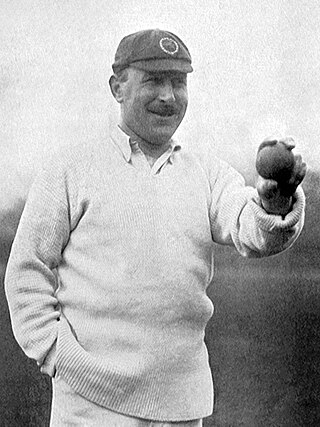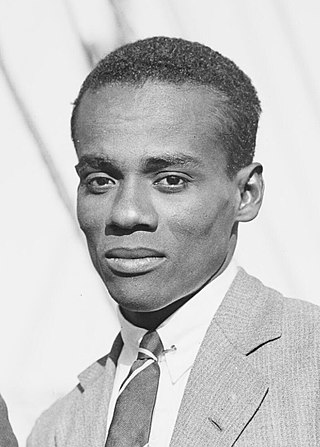
Test Cricket is a format of the sport of cricket, considered the game’s most prestigious and traditional form. Often referred to as the "ultimate test" of a cricketer's skill, endurance, and temperament, it is a format of international cricket where two teams in white clothing, each representing a country, compete over a match that can last up to five days. It consists of four innings, maximum of ninety overs are scheduled to be bowled per day making it the sport with the longest playing time. A team wins the match by outscoring the opposition in the batting or bowl out in bowling, otherwise the match ends in a draw.

Sir John Berry Hobbs was an English professional cricketer who played for Surrey from 1905 to 1934 and for England in 61 Test matches between 1908 and 1930. Known as "The Master", he is widely regarded as one of the greatest batsmen in the history of cricket. He is the leading run-scorer and century-maker in first-class cricket, with 61,760 runs and 199 centuries. A right-handed batsman and an occasional right-arm medium pace bowler, Hobbs also excelled as a fielder, particularly in the position of cover point. Hobbs was named as one of the five Wisden Cricketers of the Century alongside Sir Donald Bradman, Sir Garfield Sobers, Shane Warne, and Sir Viv Richards.
The Laws of Cricket is a code that specifies the rules of the game of cricket worldwide. The earliest known code was drafted in 1744. Since 1788, the code has been owned and maintained by the private Marylebone Cricket Club (MCC) in Lord's Cricket Ground, London. There are currently 42 Laws, which describe all aspects of how the game is to be played. MCC has re-coded the Laws six times, each with interim revisions that produce more than one edition. The most recent code, the seventh, was released in October 2017; its 3rd edition came into force on 1 October 2022.
A cricket pitch consists of the central strip of a cricket field between the two wickets. It is 22 yd (20.12 m) long and 10 ft (3.05 m) wide. The surface is flat and is normally covered with extremely short grass, but can be completely dry or dusty soil with barely any grass or, in some circumstances, made from an artificial material. Over the course of a cricket match, the pitch is not repaired or altered other than in special circumstances - meaning that it will change condition. Any grass on the pitch in the game's first over, for example, may have disappeared by the twentieth over due to wear.

This is a general glossary of the terminology used in the sport of cricket. Where words in a sentence are also defined elsewhere in this article, they appear in italics. Certain aspects of cricket terminology are explained in more detail in cricket statistics and the naming of fielding positions is explained at fielding (cricket).

Sir Leonard Hutton was an English cricketer. He played as an opening batsman for Yorkshire County Cricket Club from 1934 to 1955 and for England in 79 Test matches between 1937 and 1955. Wisden Cricketers' Almanack described him as "one of the greatest batsmen in the history of cricket". He set a record in 1938 for the highest individual innings in a Test match in only his sixth Test appearance, scoring 364 runs against Australia, a milestone that stood for nearly 20 years. Following the Second World War, he was the mainstay of England's batting. In 1952, he became the first professional cricketer of the 20th century to captain England in Tests; under his captaincy England won the Ashes the following year for the first time in 19 years.

Indoor cricket is a variant of and shares many basic concepts with cricket. The game is most often played between two teams each consisting of six or eight players.
Short form cricket is a collective term for several modified forms of the sport of cricket, with playing times significantly shorter than more traditional forms of the game.
Cricket is a multi-faceted sport with different formats, depending on the standard of play, the desired level of formality, and the time available. One of the main differences is between matches limited by time in which the teams have two innings apiece, and those limited by number of overs in which they have a single innings each. The former, known as first-class cricket if played at the senior level, has a scheduled duration of three to five days ; the latter, known as limited overs cricket because each team bowls a limit of typically 50 overs, has a planned duration of one day only. A separate form of limited overs is Twenty20, originally designed so that the whole game could be played in a single evening, in which each team has an innings limited to twenty overs.
Baseball and cricket are the best-known members of a family of related bat-and-ball games. Both have fields that are 400 feet (120 m) or more in diameter between their furthest endpoints, offensive players who can hit a thrown/"bowled" ball out of the field and run between safe areas to score runs (points) at the risk of being gotten out, and have a major game format lasting about 3 hours.
The result in a game of cricket may be a "win" for one of the two teams playing, or a "tie". In the case of a limited overs game, the game can also end with "no result" if the game can't be finished on time, and in other forms of cricket, a "draw" may be possible. Which of these results applies, and how the result is expressed, is governed by Law 16 of the laws of cricket.
Law 41 of the Laws of Cricket covers unfair play. This law has developed and expanded over time as various incidents of real life unfair play have been legislated against.

Archibald Campbell MacLaren was an English cricketer who captained the England cricket team at various times between 1898 and 1909. A right-handed batsman, he played 35 Test matches for England, as captain in 22 of those games, and led the team to defeat in four Ashes series against Australia. An amateur, MacLaren played first-class cricket for Lancashire, captaining that county for most of his career. As a batsman, MacLaren was one of the leading cricketers of his time and had a reputation as a fast-scoring stylist. In 1895, he scored 424 runs in an innings against Somerset which was the highest individual score in first-class cricket until 1923 and remained a record in English cricket until 1994. Opinions were divided over his captaincy. He was a deep thinker on the game and critics believed him to be tactically advanced, but his pessimism, clashes with the selectors and inability to get the best out of his players led most commentators to rate him a poor leader.

In cricket, a scorer is someone appointed to record all runs scored, all wickets taken and, where appropriate, the number of overs bowled. In professional games, in compliance with Law 3 of the Laws of Cricket, two scorers are appointed, most often one provided by each team.

Robert Peel was an English professional cricketer who played first-class cricket for Yorkshire between 1883 and 1897. Primarily a left-arm spin bowler, Peel was also an effective left-handed batsman who played in the middle order. Between 1884 and 1896, he was regularly selected to represent England, playing 20 Test matches in which he took 101 wickets. Over the course of his career, he scored 12,191 runs and took 1,775 wickets in first-class cricket. A match-winning bowler, particularly when conditions favoured his style, Peel generally opened the attack, an orthodox tactic for a spinner at the time, and was highly regarded by critics.

George Herbert Hirst was a professional English cricketer who played first-class cricket for Yorkshire County Cricket Club between 1891 and 1921, with a further appearance in 1929. One of the best all-rounders of his time, Hirst was a left arm medium-fast bowler and right-handed batsman. He played in 24 Test matches for England between 1897 and 1909, touring Australia twice. He completed the double of 1,000 runs and 100 wickets in an English cricket season 14 times, the second most of any cricketer after his contemporary and team-mate Wilfred Rhodes. One of the Wisden Cricketers of the Year for 1901, Hirst scored 36,356 runs and took 2,742 wickets in first-class cricket. In Tests, he made 790 runs and captured 59 wickets.

Edwin Lloyd St Hill was a Trinidadian cricketer who played two Test matches for the West Indies in 1930. His brothers, Wilton and Cyl, also played for Trinidad and Tobago; in addition, the former played Test matches for the West Indies.

Cricket is a bat-and-ball game played between two teams of eleven players on a field, at the centre of which is a 22-yard pitch with a wicket at each end, each comprising two bails balanced on three stumps. Two players from the batting team, the striker and nonstriker, stand in front of either wicket holding bats, while one player from the fielding team, the bowler, bowls the ball toward the striker's wicket from the opposite end of the pitch. The striker's goal is to hit the bowled ball with the bat and then switch places with the nonstriker, with the batting team scoring one run for each of these exchanges. Runs are also scored when the ball reaches the boundary of the field or when the ball is bowled illegally.

Sir John Berry "Jack" Hobbs was an English professional cricketer who played for Surrey from 1905 to 1934 and for England in 61 Test matches between 1908 and 1930. Born into poverty in Cambridge, Hobbs displayed little distinction as a cricketer until relatively late in life. After some limited early success, he began to aspire to a career in professional cricket, and a sudden improvement in 1901 made this more likely. Following the death of his father, the whole family depended on Hobbs but he was supported by Tom Hayward, a professional cricketer who played for Surrey. Hayward arranged for Hobbs to have a trial at Surrey, and after he was successful, Hobbs spent two years qualifying to play County Cricket.

Vivian Frank Shergold Crawford was an English cricketer who played as a right-handed batsman and an occasional right-arm fast bowler in first-class cricket for Surrey and Leicestershire between 1896 and 1910. He also played for many amateur teams. He was born in Leicester and died at Merton, Surrey. He was the brother of the England Test cricketer Jack Crawford and of the Leicestershire first-class cricketer Reginald Crawford.














